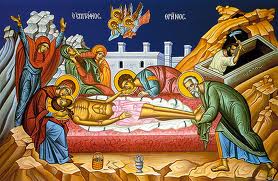I wrote this last year – applies again.
I found this on something called Easter Icons – “It is hard to imagine the Easter story without thinking of the resurrection, and often we teach the Good Friday message as if it was Easter Day. The Disciples and followers of Jesus, and his family, did not have the luxury of being able to skip to the end of the book. Good Friday is the day where all hope is lost. While Jesus remained alive on the cross, there was still some hope of a miracle. But, by the end of Good Friday, Jesus is dead. All hope is lost, and it becomes clear that Jesus is not the Messiah. The Disciples look and feel like fools. The strange and horrific events they had just experienced would still have been fresh and vivid. Saturday would have felt decidedly unholy for the Disciples, whilst the majority of people around them, including perhaps their family, were celebrating the festivities of Passover and the Festival of Unleavened Bread. They were alone and abandoned, and all hope was gone… This is the Christian story, this is the Christian faith: Jesus dies. This is no pretence. Jesus is laid in a tomb. This is no fairytale. Death comes and death is faced … and death is defeated … but not on Good Friday or on the Saturday. Today we wait and contemplate the death of Jesus.”
So we have quiet Saturday. Also known as the Easter Vigil (a name more properly applied to the Mass on Holy Saturday night), Holy Saturday has had a long and varied history. As the Catholic Encyclopedia notes, “in the early Church this was the only Saturday on which fasting was permitted.” Fasting is a sign of penance, but on Good Friday, Christ paid with His own Blood the debt of our sins. Thus, for many centuries, Christians regarded both Saturday and Sunday, the day of Christ’s Resurrection, as days on which fasting was forbidden.
I like it because it is a chance to catch a breath before Easter Sunday Worship


